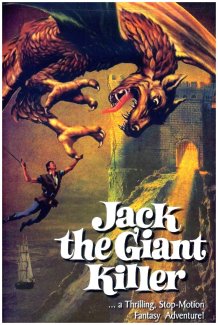

Jack the Giant Killer is also sprinkled with homages to other fantasy films such as Pendragon's transformation into a winged dragon which references the climax of Walt Disney's Sleeping Beauty (1959), the one-armed torch holders mounted on Pendragon's walls are a direct nod to Jean Cocteau's Beauty and the Beast (1946), and the solarized demons who descend on Jack's ship at sea appear to be modeled on the banshee from Disney's Darby O'Gill and the Little People (1959). And, like Sinbad who battled mythical creatures on Sokurah's enchanted island of Colossa, Jack must infiltrate Pendragon's fortress, which is inhabited by supernatural beings, to save Princess Elaine (Judi Meredith). In Sinbad, the hero had the help of a genie in a lamp, in Jack the Giant Killer, he relies on the powers of a leprechaun imprisoned in a bottle. There was a time when the Kingdom of Cornwall lived in fear and trembling of the Black Prince Pendragon - master of witches, giants and hobgoblins - who ravished the land." Although the screenplay was actually based on Cornish folk tales and myths, the storyline is strikingly similar to The 7th Voyage of Sinbad in its tale of a princess who is abducted by a sorcerer and her rescuer who is aided in his quest by magic.

Produced by Edward Small, it reunited the director of Sinbad - Nathan Juran - with its star (Kerwin Mathews) and even featured Torin Thatcher, the villainous magician Sokurah of Sinbad, as yet another evil wizard.Īccording to the film's prologue, "The legend of Jack the Giant Killer was born over a thousand years ago in Cornwall, England near Land's End. However, the most glaring attempt to reproduce the success of The 7th Voyage of Sinbad was Jack the Giant Killer (1961). Gordon's The Magic Sword (1962), and Captain Sinbad (1963). Among the many imitations that followed in its wake were The Wizard of Baghdad (1960), The Wonders of Aladdin (1961), The Thief of Bagdad (1961) with Steve Reeves, Bert I. Ray Harryhausen's magical stop-motion animation effects, Kerwin Mathews' athletic hero and Bernard Herrmann's dramatic score set a high standard for the genre that was rarely matched.
JACK THE GIANT KILLER MUSICAL FREE
Jack and the princess are now free to live happily ever after.įor children, particularly young boys, who spent Saturdays attending the kiddie matinee at their local cinema during the fifties, The 7th Voyage of Sinbad (1958) was the holy grail of fantasy-adventure films. The imp, who is really a leprechaun, is freed from his bottle and permitted to walk a rainbow to his home in Ireland. As Pendragon plunges into the sea, his magic and creatures of evil die with him. Jack is carried off but slays the dragon in mid-air. As they sail from the island together, Pendragon transforms himself into a flying dragon and attacks their small craft.

The imp calls up a many-tentacled sea monster, who kills the giant in a fierce battle, aided by Jack, the dog, and the chimpanzee. Jack breaks the evil spell the sorcerer has cast over the princess, but as they return to the boat Pendragon sends a two-headed giant against them. Jack escapes though, and Sigurd is transformed into a dog and Peter into a chimpanzee. With the help of his new friends, Jack rescues Elaine, but she has been bewitched and betrays him. They are rescued by an old Viking, Sigurd, who possesses a magic imp imprisoned in a bottle. Their ship is intercepted by Pendragon's ghouls and witches, and Elaine is captured, while Jack and 12-year-old Peter are cast overboard. The grateful king appoints Jack as Elaine's protector and entrusts him to spirit her to the safety of a convent across the sea. She is saved by Jack, a farmer's son, who kills the giant with his ax. Pendragon, Master of Demons, is banished from ancient England and strives to regain his power by having one of his giants abduct King Mark's daughter, the Princess Elaine.


 0 kommentar(er)
0 kommentar(er)
